Technical Area | Articles
The place to solve all your BIM doubts
How BIM-based integrated solution powers prefabrication
A sucess story
BIM Implementation Construcción Offsite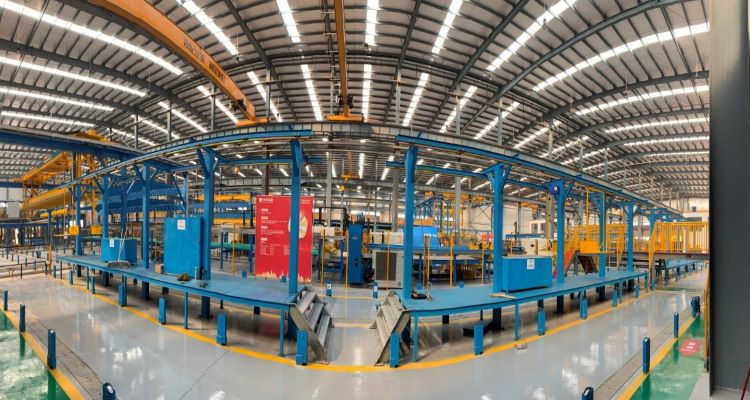
Prefabrication is hardly a new concept for construction. Back in 1929, American architect Richard Buckminster Fuller developed the first modular house, The Dymaxion House. This house was made from a container and was assembled on-site with a key design consideration for the Dymaxion House being ease of shipment and assembly.
Fast forward to 2020. From January 24 to February 2, 2020, the world witnessed a prefab hospital being raised in Wuhan, China, during the initial outbreak of COVID-19. By using prefabrication construction methods, the over-1,000-bed Huoshenshan hospital with the size of about 5 football fields, was completed and delivered within 10 days. This once again proved how the efficiency and cost-effectiveness of the prefabricated building make the impossible possible, particularly during challenging times.
Compared to conventional buildings, the benefits of prefabricated buildings include:
How iTWO Smart Production supports the precast process from the software side
iTWO Smart Production empowers a fully integrated and digitalized production workflow. Equipped with a centralized database, it enables automated management of the entire prefabrication production process, from sales and resource planning, production, to logistics and mounting. With an intuitive user interface, the system allows for smooth workflow management, provides users with an illustrated overview of the work procedures, and supplies machines with required digital information.
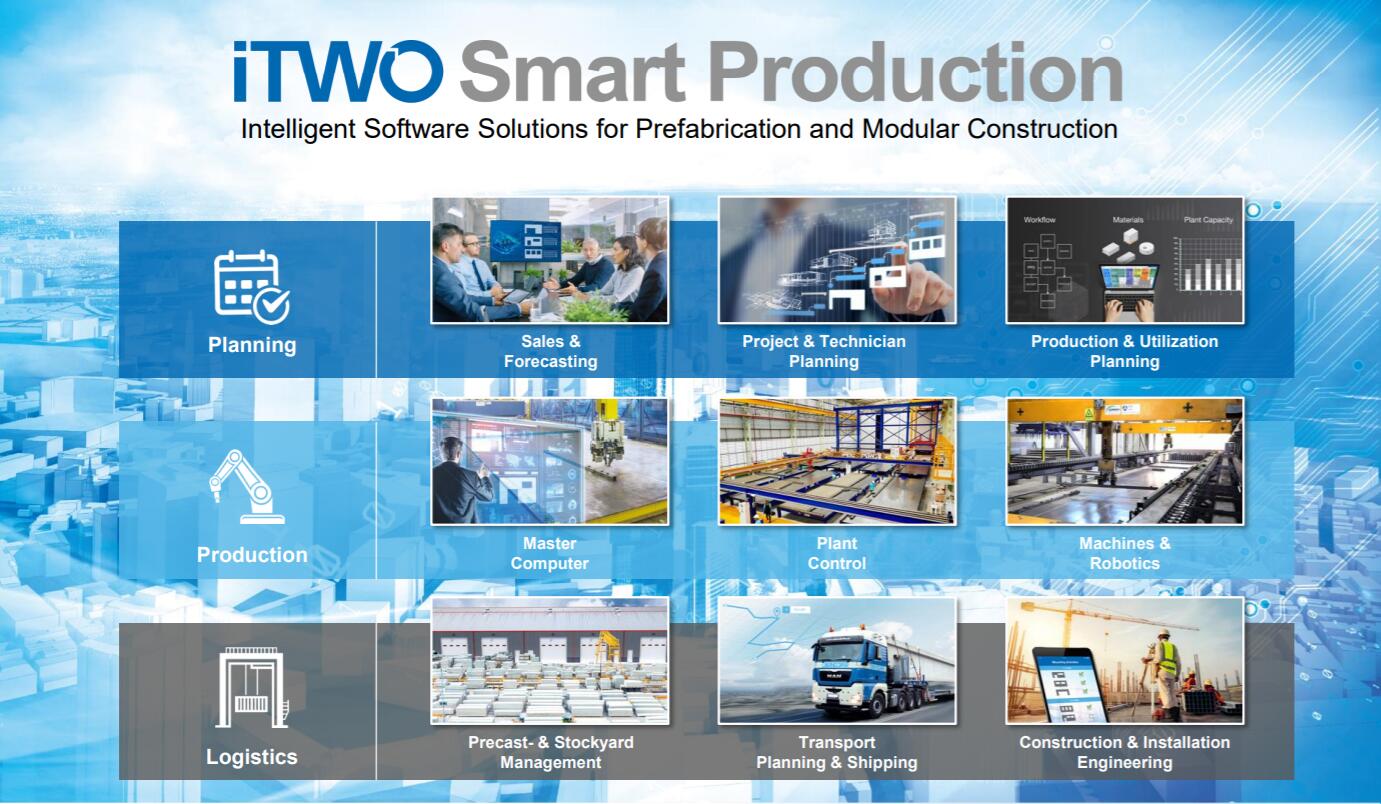
BIM-based production process with iTWO Smart Production
1. Design & sales: The entire sales process through to the award of the contract is usually handled in this phase. Components derived from the 3D building model are used for the calculation of costs and construction planning (5D BIM). Components suitable for prefabrication will be unitized into producible parts and supplemented with all necessary geometric details and material properties for calculations.
2. Resource planning: All resources (production capacity, materials, human resources) are calculated and set according to the delivery and installation date. Based on the data the planning for one or multiple production sites can be managed to optimize production.
3. Production release: Once the necessary approvals have been obtained and the materials have been delivered, the production release is granted, and the data will be transferred to the MES (Production Master Computer) system of an automated production line.
4. Production planning and monitoring: The producibility of BIM data will be checked and optimally planned in the MES system. The data release for the connected production machines also takes place. The confirmed process and production data will be collected in the control system, stored, and made available for visualization, reporting and analysis tools.
5. Production: At the prefabrication production plant, the connected production machines receive all necessary data and commands from MES to carry out product-specific production steps: shuttering, reinforcing, concreting & packing, hardening, and after-treating.
6. Storage and transport: Once the precast elements leave the production hall - already stacked in delivery units, the data is processed in the PPS (Production Planning & Scheduling) system.
7. Mounting: Typical tasks at the installation sequence are digitally managed and controlled: schedule installation teams, call for deliveries from the plant, create progress reports, and manage construction machines.
BIM-powered prefabrication in practice: a success story
Established in 1989 and headquartered in Wuhan, China, MHOME Group is a developer of residential and urban homes properties and provider of urban and rural construction services. The company has been listed in the 2021 China Top 100 Real Estate Developers.
RIB Software and MHOME started their technology partnership from June 2017 for the prefabrication digitalization commitment of MHOME. In September 2018, the iTWO platform went live at MHOME, and in October iTWO PPS was launched. The MHOME - iTWO 5D BIM Enterprise Cloud Platform covers the entire SEPC industry chain process. Initiated by MHOME with ‘service’ as its core, the SEPC mode innovatively integrates traditional EPC (Engineering Procurement Construction) with MHOME’s s social responsibility for developers and owners. RIB also further tailored the iTWO platform for the business process of MHOME. The system covers the entire process from project setup, inspection, delivery, including end-to-end product development and production chain.
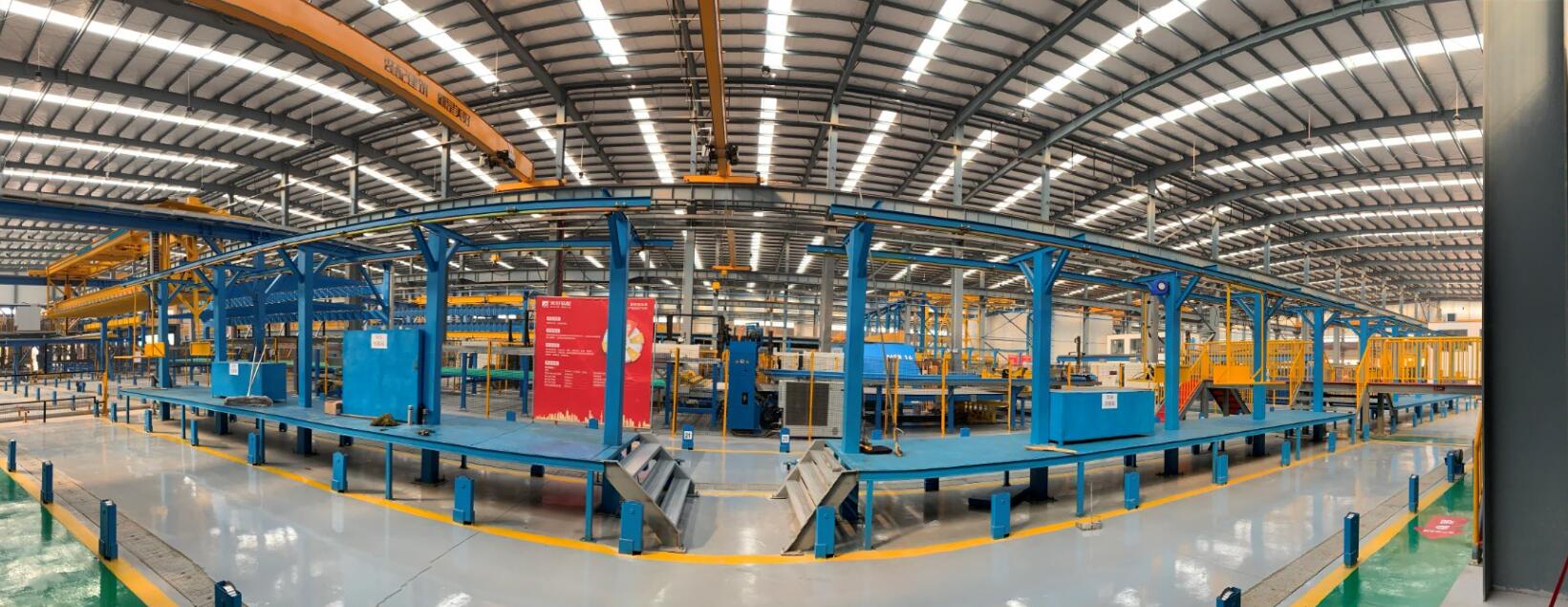
MHOME Jiangxia Prefabrication Plant
MHOME has built an innovative smart cloud management platform with BIM technology from RIB Software, allowing MHOME to manage the entire prefabrication construction process. In addition, real-time information sharing improves process transparency, realizes lean production, ensures precise procurement and optimized warehousing, provides digital support for the expansion of prefabricated construction, and ultimately realizes MHOME Group's mission to allow more people to live a better life through beautiful, easy-to-use, and affordable housing.
With the iTWO platform, MHOME planned and installed its entire digital intelligent operation system. Specifically, MHOME uses iTWO platform for its operation aspects such as cost management, quantity-takeoff and estimation, procurement and payment, scheduling, quality and safety management, as well as production management for its nationwide prefabrication plants.
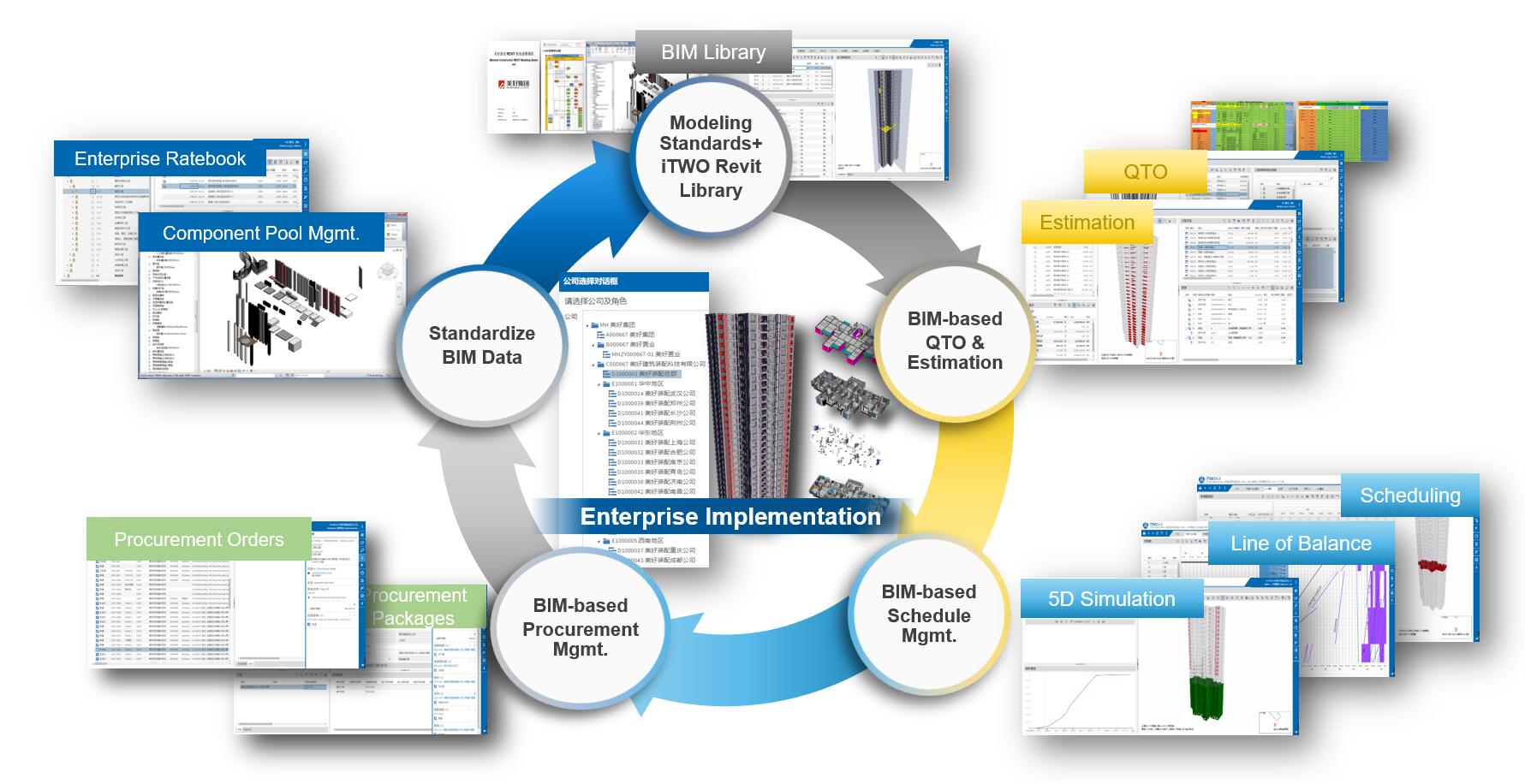
MHOME’s prefabricated project listed as an intelligence construction pilot project in China
MHOME was rated by China's Ministry of Housing and Urban-Rural Development (MOHURD) as a "National Prefabricated Construction Industry Base". On February 2, 2021, MHOME's Tianfu Project in Chongqing was listed as one of the intelligent construction demonstration projects by MOHURD, further consolidating its leading position in the industry.
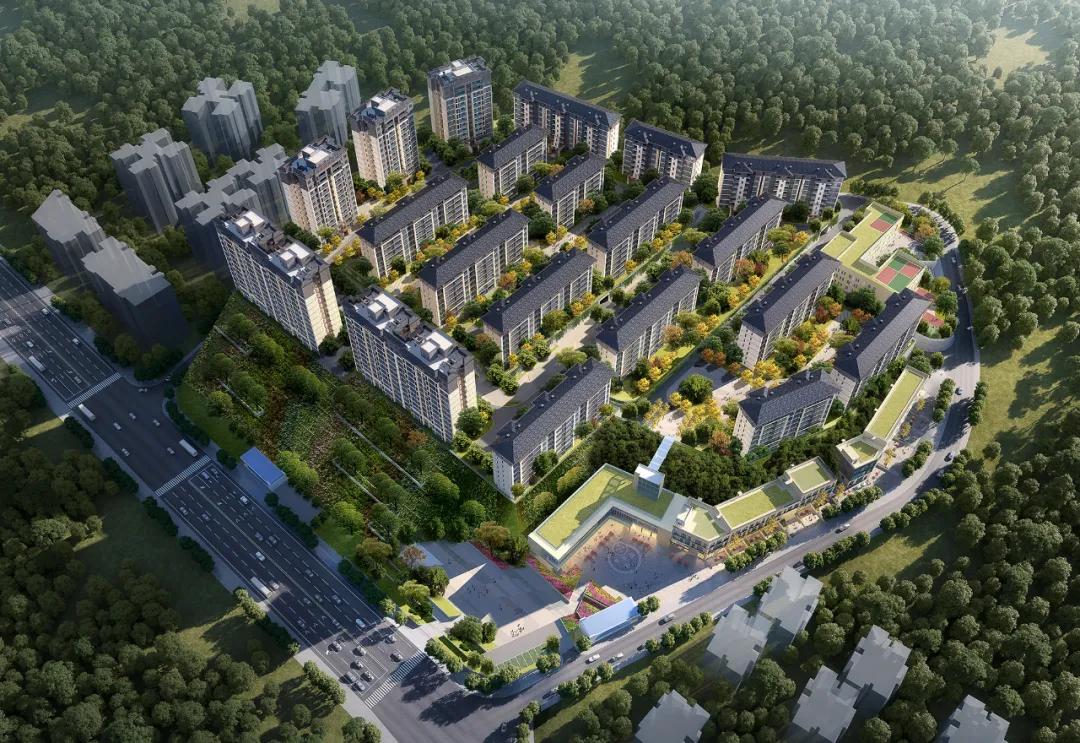
Rendering of the Chongqing Tianfu Project, Image from MHOME
The Chongqing Tianfu Project is located in Jiangbei District, Chongqing, on the north bank of the Yangtze River and Jialing River. The project is a comprehensive demonstration project of prefabricated concrete residential buildings constructed in accordance with the Chinese national A-level prefabricated building standards (namely, the assembly rate should be over 60% and the proportion of vertical components should be no less than 35%) and the two-star (out of 3 stars) standard of Chinese assessment standard for green building.
The total construction area of the project is about 145,900 square meters, including over 20 high-rise residential buildings, all of which are constructed using the assembly integral laminated shear wall technology system, with an assembly rate of 65%.
Under the premise of a high assembly rate, the project increased the implementation of digitalization and intelligence in all aspects of construction. Through BIM integrated design, intelligent manufacturing, and construction, it realized standardized design, plant production, prefabricated construction, and integrated decoration and digital management, to improve quality, safety, and efficiency. The project stood out from many alternative pilot project candidates with its strength.
ResearchandMarkets.com reports that the global modular construction market size is projected to grow from USD 82.3 billion in 2020 to USD 108.8 billion by 2025, at a CAGR of 5.75% from 2020 to 2025. The growth of this market is attributed to increase in concern towards work-zone safety, the need for lower environmental impacts, supportive government initiatives, and an increase in population and rapid urbanization.
Fast forward to 2020. From January 24 to February 2, 2020, the world witnessed a prefab hospital being raised in Wuhan, China, during the initial outbreak of COVID-19. By using prefabrication construction methods, the over-1,000-bed Huoshenshan hospital with the size of about 5 football fields, was completed and delivered within 10 days. This once again proved how the efficiency and cost-effectiveness of the prefabricated building make the impossible possible, particularly during challenging times.
Compared to conventional buildings, the benefits of prefabricated buildings include:
- Industrial prefabrication with no or little influence from weather
- Better quality control in the production plant environment
- Cost-effective due to efficient production methods
- Sustainability from optimized material usage
- Shorter construction time thanks to its contemporaneous nature
How iTWO Smart Production supports the precast process from the software side
iTWO Smart Production empowers a fully integrated and digitalized production workflow. Equipped with a centralized database, it enables automated management of the entire prefabrication production process, from sales and resource planning, production, to logistics and mounting. With an intuitive user interface, the system allows for smooth workflow management, provides users with an illustrated overview of the work procedures, and supplies machines with required digital information.

BIM-based production process with iTWO Smart Production
1. Design & sales: The entire sales process through to the award of the contract is usually handled in this phase. Components derived from the 3D building model are used for the calculation of costs and construction planning (5D BIM). Components suitable for prefabrication will be unitized into producible parts and supplemented with all necessary geometric details and material properties for calculations.
2. Resource planning: All resources (production capacity, materials, human resources) are calculated and set according to the delivery and installation date. Based on the data the planning for one or multiple production sites can be managed to optimize production.
3. Production release: Once the necessary approvals have been obtained and the materials have been delivered, the production release is granted, and the data will be transferred to the MES (Production Master Computer) system of an automated production line.
4. Production planning and monitoring: The producibility of BIM data will be checked and optimally planned in the MES system. The data release for the connected production machines also takes place. The confirmed process and production data will be collected in the control system, stored, and made available for visualization, reporting and analysis tools.
5. Production: At the prefabrication production plant, the connected production machines receive all necessary data and commands from MES to carry out product-specific production steps: shuttering, reinforcing, concreting & packing, hardening, and after-treating.
6. Storage and transport: Once the precast elements leave the production hall - already stacked in delivery units, the data is processed in the PPS (Production Planning & Scheduling) system.
7. Mounting: Typical tasks at the installation sequence are digitally managed and controlled: schedule installation teams, call for deliveries from the plant, create progress reports, and manage construction machines.
BIM-powered prefabrication in practice: a success story
Established in 1989 and headquartered in Wuhan, China, MHOME Group is a developer of residential and urban homes properties and provider of urban and rural construction services. The company has been listed in the 2021 China Top 100 Real Estate Developers.
RIB Software and MHOME started their technology partnership from June 2017 for the prefabrication digitalization commitment of MHOME. In September 2018, the iTWO platform went live at MHOME, and in October iTWO PPS was launched. The MHOME - iTWO 5D BIM Enterprise Cloud Platform covers the entire SEPC industry chain process. Initiated by MHOME with ‘service’ as its core, the SEPC mode innovatively integrates traditional EPC (Engineering Procurement Construction) with MHOME’s s social responsibility for developers and owners. RIB also further tailored the iTWO platform for the business process of MHOME. The system covers the entire process from project setup, inspection, delivery, including end-to-end product development and production chain.

MHOME Jiangxia Prefabrication Plant
iTWO platform as the core information management system of MHOME
MHOME has built an innovative smart cloud management platform with BIM technology from RIB Software, allowing MHOME to manage the entire prefabrication construction process. In addition, real-time information sharing improves process transparency, realizes lean production, ensures precise procurement and optimized warehousing, provides digital support for the expansion of prefabricated construction, and ultimately realizes MHOME Group's mission to allow more people to live a better life through beautiful, easy-to-use, and affordable housing.
With the iTWO platform, MHOME planned and installed its entire digital intelligent operation system. Specifically, MHOME uses iTWO platform for its operation aspects such as cost management, quantity-takeoff and estimation, procurement and payment, scheduling, quality and safety management, as well as production management for its nationwide prefabrication plants.

MHOME’s prefabricated project listed as an intelligence construction pilot project in China
MHOME was rated by China's Ministry of Housing and Urban-Rural Development (MOHURD) as a "National Prefabricated Construction Industry Base". On February 2, 2021, MHOME's Tianfu Project in Chongqing was listed as one of the intelligent construction demonstration projects by MOHURD, further consolidating its leading position in the industry.

Rendering of the Chongqing Tianfu Project, Image from MHOME
The Chongqing Tianfu Project is located in Jiangbei District, Chongqing, on the north bank of the Yangtze River and Jialing River. The project is a comprehensive demonstration project of prefabricated concrete residential buildings constructed in accordance with the Chinese national A-level prefabricated building standards (namely, the assembly rate should be over 60% and the proportion of vertical components should be no less than 35%) and the two-star (out of 3 stars) standard of Chinese assessment standard for green building.
The total construction area of the project is about 145,900 square meters, including over 20 high-rise residential buildings, all of which are constructed using the assembly integral laminated shear wall technology system, with an assembly rate of 65%.
Under the premise of a high assembly rate, the project increased the implementation of digitalization and intelligence in all aspects of construction. Through BIM integrated design, intelligent manufacturing, and construction, it realized standardized design, plant production, prefabricated construction, and integrated decoration and digital management, to improve quality, safety, and efficiency. The project stood out from many alternative pilot project candidates with its strength.
ResearchandMarkets.com reports that the global modular construction market size is projected to grow from USD 82.3 billion in 2020 to USD 108.8 billion by 2025, at a CAGR of 5.75% from 2020 to 2025. The growth of this market is attributed to increase in concern towards work-zone safety, the need for lower environmental impacts, supportive government initiatives, and an increase in population and rapid urbanization.











